Australian Agriculture: Environment Management System and ISO 14001
VerifiedAdded on 2023/06/05
|8
|1928
|453
Report
AI Summary
This report examines the application of environment management systems (EMS) within the Australian agricultural sector, emphasizing the importance of ISO 14001 standards for enhancing environmental performance. It highlights the benefits of ISO 14001, such as improved resource efficiency, stakeholder trust, and competitive advantage, while also addressing the need for stronger leadership commitment and proactive environmental protection measures. The report discusses the detrimental effects of air, water, and soil pollution, advocating for the adoption of innovative environmental practices across various industries, including the soft drinks and IT sectors. Examples of sustainable water management, plastic recycling, and energy conservation are provided to illustrate how organizations can minimize their environmental impact and promote a more sustainable future. The document emphasizes the role of ISO standards in ensuring a healthy environment and promoting the efficient use of resources for long-term sustainability, inviting more innovation towards eco-friendly operations.
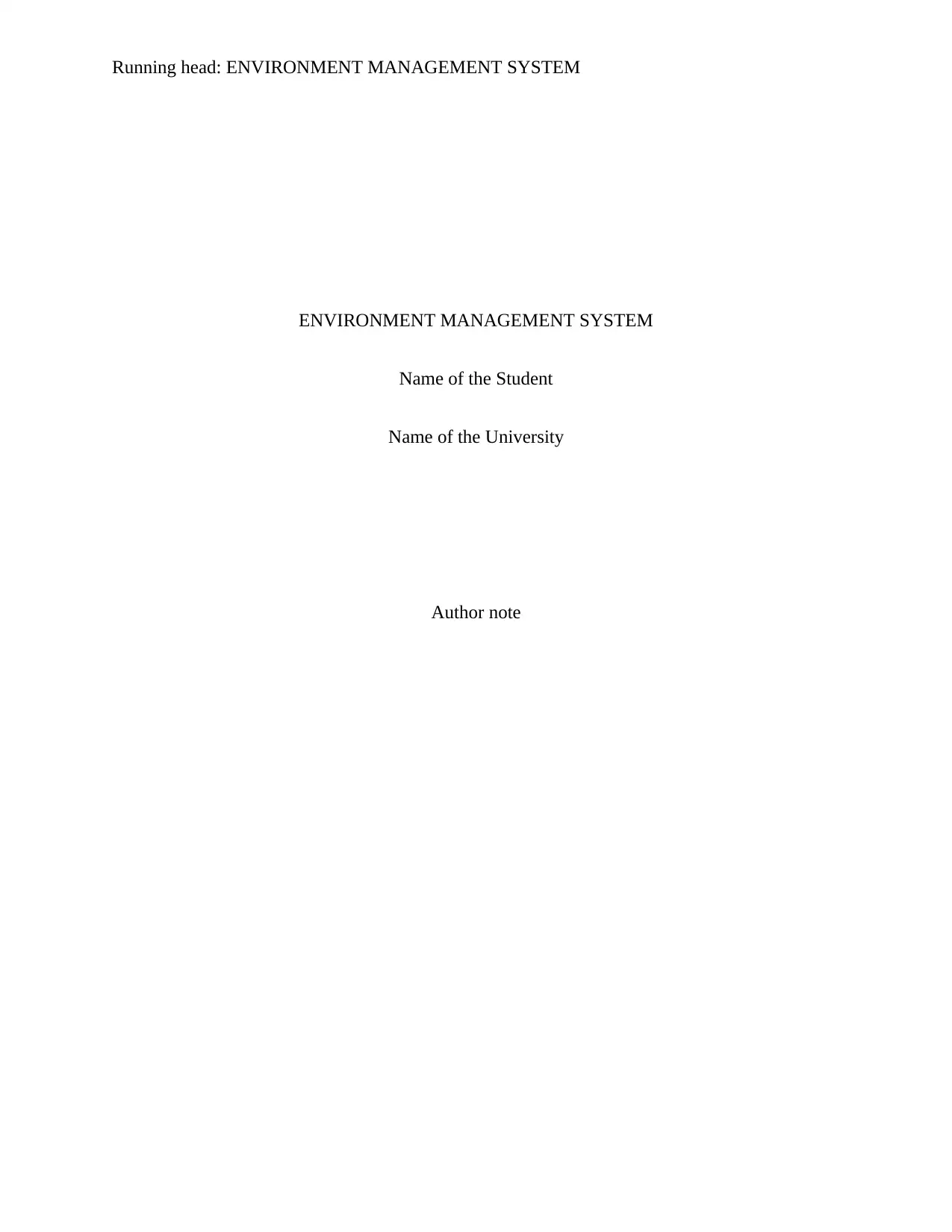
Running head: ENVIRONMENT MANAGEMENT SYSTEM
ENVIRONMENT MANAGEMENT SYSTEM
Name of the Student
Name of the University
Author note
ENVIRONMENT MANAGEMENT SYSTEM
Name of the Student
Name of the University
Author note
Paraphrase This Document
Need a fresh take? Get an instant paraphrase of this document with our AI Paraphraser
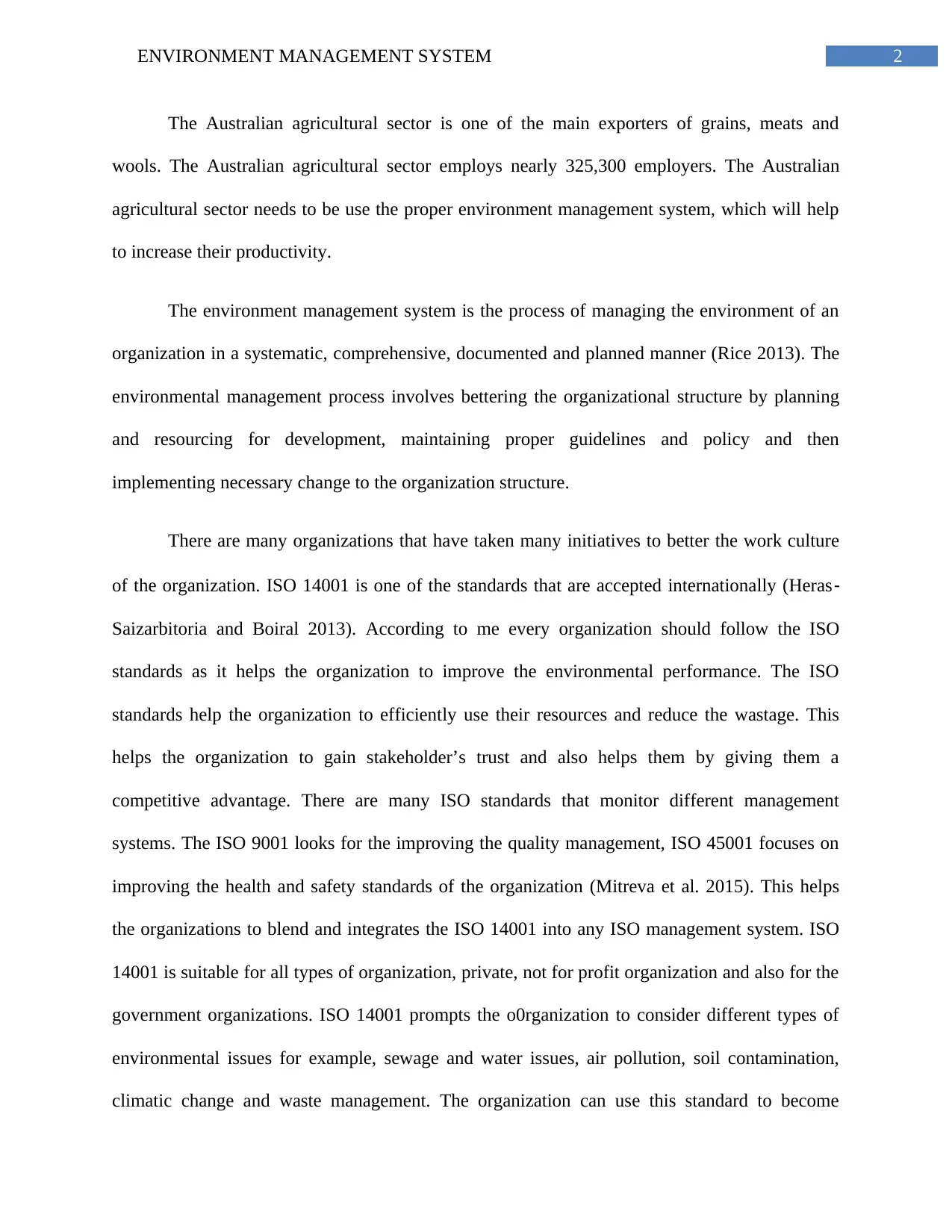
2ENVIRONMENT MANAGEMENT SYSTEM
The Australian agricultural sector is one of the main exporters of grains, meats and
wools. The Australian agricultural sector employs nearly 325,300 employers. The Australian
agricultural sector needs to be use the proper environment management system, which will help
to increase their productivity.
The environment management system is the process of managing the environment of an
organization in a systematic, comprehensive, documented and planned manner (Rice 2013). The
environmental management process involves bettering the organizational structure by planning
and resourcing for development, maintaining proper guidelines and policy and then
implementing necessary change to the organization structure.
There are many organizations that have taken many initiatives to better the work culture
of the organization. ISO 14001 is one of the standards that are accepted internationally (Heras‐
Saizarbitoria and Boiral 2013). According to me every organization should follow the ISO
standards as it helps the organization to improve the environmental performance. The ISO
standards help the organization to efficiently use their resources and reduce the wastage. This
helps the organization to gain stakeholder’s trust and also helps them by giving them a
competitive advantage. There are many ISO standards that monitor different management
systems. The ISO 9001 looks for the improving the quality management, ISO 45001 focuses on
improving the health and safety standards of the organization (Mitreva et al. 2015). This helps
the organizations to blend and integrates the ISO 14001 into any ISO management system. ISO
14001 is suitable for all types of organization, private, not for profit organization and also for the
government organizations. ISO 14001 prompts the o0rganization to consider different types of
environmental issues for example, sewage and water issues, air pollution, soil contamination,
climatic change and waste management. The organization can use this standard to become
The Australian agricultural sector is one of the main exporters of grains, meats and
wools. The Australian agricultural sector employs nearly 325,300 employers. The Australian
agricultural sector needs to be use the proper environment management system, which will help
to increase their productivity.
The environment management system is the process of managing the environment of an
organization in a systematic, comprehensive, documented and planned manner (Rice 2013). The
environmental management process involves bettering the organizational structure by planning
and resourcing for development, maintaining proper guidelines and policy and then
implementing necessary change to the organization structure.
There are many organizations that have taken many initiatives to better the work culture
of the organization. ISO 14001 is one of the standards that are accepted internationally (Heras‐
Saizarbitoria and Boiral 2013). According to me every organization should follow the ISO
standards as it helps the organization to improve the environmental performance. The ISO
standards help the organization to efficiently use their resources and reduce the wastage. This
helps the organization to gain stakeholder’s trust and also helps them by giving them a
competitive advantage. There are many ISO standards that monitor different management
systems. The ISO 9001 looks for the improving the quality management, ISO 45001 focuses on
improving the health and safety standards of the organization (Mitreva et al. 2015). This helps
the organizations to blend and integrates the ISO 14001 into any ISO management system. ISO
14001 is suitable for all types of organization, private, not for profit organization and also for the
government organizations. ISO 14001 prompts the o0rganization to consider different types of
environmental issues for example, sewage and water issues, air pollution, soil contamination,
climatic change and waste management. The organization can use this standard to become
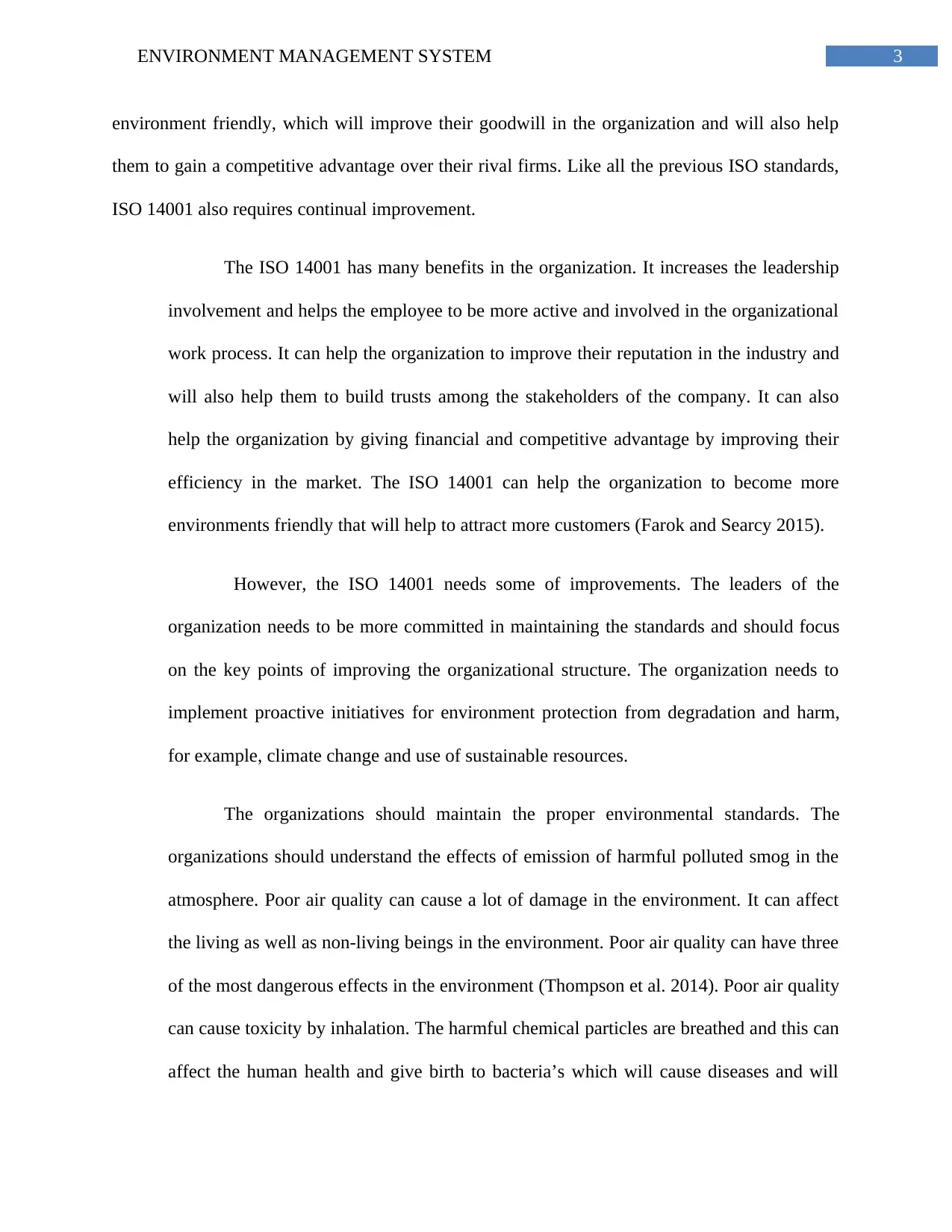
3ENVIRONMENT MANAGEMENT SYSTEM
environment friendly, which will improve their goodwill in the organization and will also help
them to gain a competitive advantage over their rival firms. Like all the previous ISO standards,
ISO 14001 also requires continual improvement.
The ISO 14001 has many benefits in the organization. It increases the leadership
involvement and helps the employee to be more active and involved in the organizational
work process. It can help the organization to improve their reputation in the industry and
will also help them to build trusts among the stakeholders of the company. It can also
help the organization by giving financial and competitive advantage by improving their
efficiency in the market. The ISO 14001 can help the organization to become more
environments friendly that will help to attract more customers (Farok and Searcy 2015).
However, the ISO 14001 needs some of improvements. The leaders of the
organization needs to be more committed in maintaining the standards and should focus
on the key points of improving the organizational structure. The organization needs to
implement proactive initiatives for environment protection from degradation and harm,
for example, climate change and use of sustainable resources.
The organizations should maintain the proper environmental standards. The
organizations should understand the effects of emission of harmful polluted smog in the
atmosphere. Poor air quality can cause a lot of damage in the environment. It can affect
the living as well as non-living beings in the environment. Poor air quality can have three
of the most dangerous effects in the environment (Thompson et al. 2014). Poor air quality
can cause toxicity by inhalation. The harmful chemical particles are breathed and this can
affect the human health and give birth to bacteria’s which will cause diseases and will
environment friendly, which will improve their goodwill in the organization and will also help
them to gain a competitive advantage over their rival firms. Like all the previous ISO standards,
ISO 14001 also requires continual improvement.
The ISO 14001 has many benefits in the organization. It increases the leadership
involvement and helps the employee to be more active and involved in the organizational
work process. It can help the organization to improve their reputation in the industry and
will also help them to build trusts among the stakeholders of the company. It can also
help the organization by giving financial and competitive advantage by improving their
efficiency in the market. The ISO 14001 can help the organization to become more
environments friendly that will help to attract more customers (Farok and Searcy 2015).
However, the ISO 14001 needs some of improvements. The leaders of the
organization needs to be more committed in maintaining the standards and should focus
on the key points of improving the organizational structure. The organization needs to
implement proactive initiatives for environment protection from degradation and harm,
for example, climate change and use of sustainable resources.
The organizations should maintain the proper environmental standards. The
organizations should understand the effects of emission of harmful polluted smog in the
atmosphere. Poor air quality can cause a lot of damage in the environment. It can affect
the living as well as non-living beings in the environment. Poor air quality can have three
of the most dangerous effects in the environment (Thompson et al. 2014). Poor air quality
can cause toxicity by inhalation. The harmful chemical particles are breathed and this can
affect the human health and give birth to bacteria’s which will cause diseases and will
⊘ This is a preview!⊘
Do you want full access?
Subscribe today to unlock all pages.

Trusted by 1+ million students worldwide
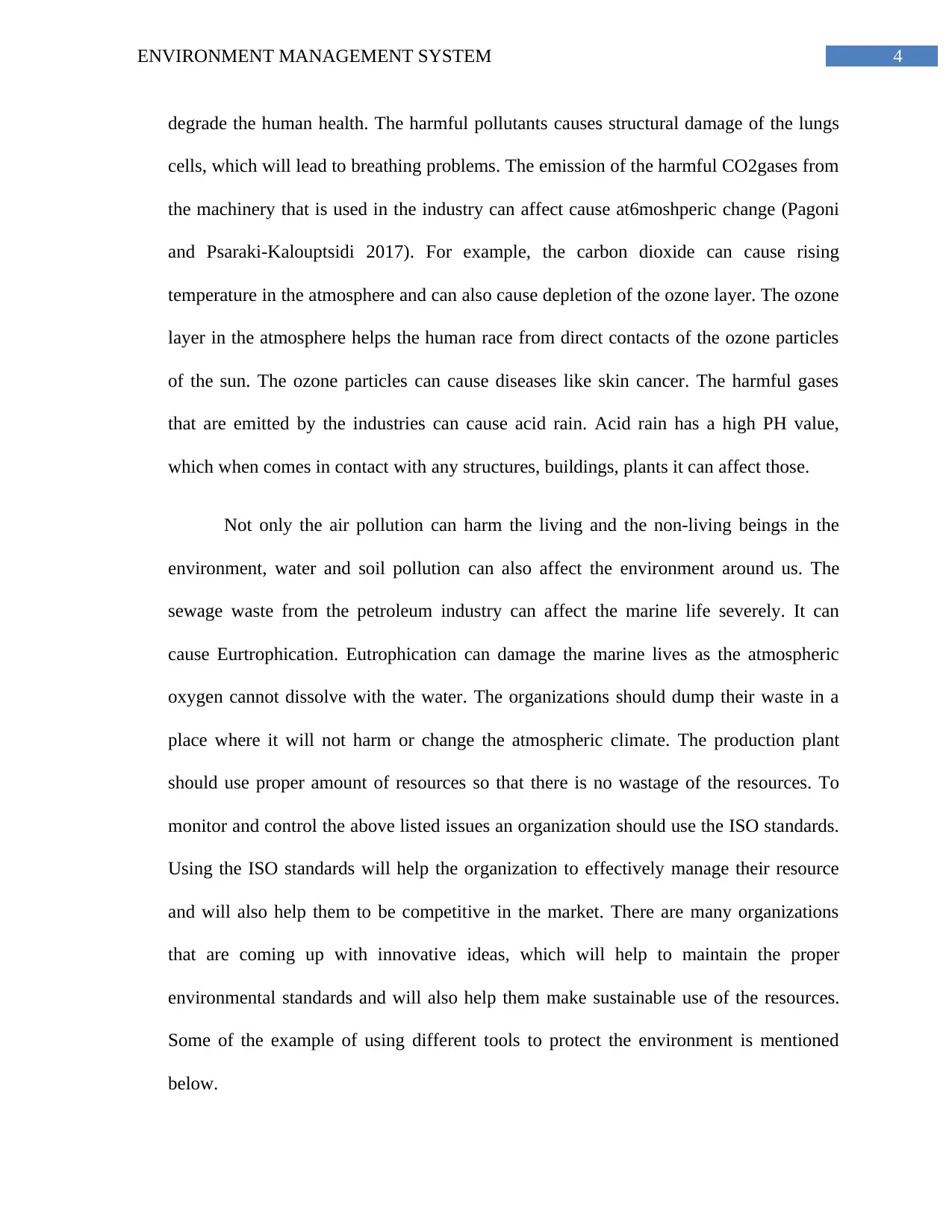
4ENVIRONMENT MANAGEMENT SYSTEM
degrade the human health. The harmful pollutants causes structural damage of the lungs
cells, which will lead to breathing problems. The emission of the harmful CO2gases from
the machinery that is used in the industry can affect cause at6moshperic change (Pagoni
and Psaraki-Kalouptsidi 2017). For example, the carbon dioxide can cause rising
temperature in the atmosphere and can also cause depletion of the ozone layer. The ozone
layer in the atmosphere helps the human race from direct contacts of the ozone particles
of the sun. The ozone particles can cause diseases like skin cancer. The harmful gases
that are emitted by the industries can cause acid rain. Acid rain has a high PH value,
which when comes in contact with any structures, buildings, plants it can affect those.
Not only the air pollution can harm the living and the non-living beings in the
environment, water and soil pollution can also affect the environment around us. The
sewage waste from the petroleum industry can affect the marine life severely. It can
cause Eurtrophication. Eutrophication can damage the marine lives as the atmospheric
oxygen cannot dissolve with the water. The organizations should dump their waste in a
place where it will not harm or change the atmospheric climate. The production plant
should use proper amount of resources so that there is no wastage of the resources. To
monitor and control the above listed issues an organization should use the ISO standards.
Using the ISO standards will help the organization to effectively manage their resource
and will also help them to be competitive in the market. There are many organizations
that are coming up with innovative ideas, which will help to maintain the proper
environmental standards and will also help them make sustainable use of the resources.
Some of the example of using different tools to protect the environment is mentioned
below.
degrade the human health. The harmful pollutants causes structural damage of the lungs
cells, which will lead to breathing problems. The emission of the harmful CO2gases from
the machinery that is used in the industry can affect cause at6moshperic change (Pagoni
and Psaraki-Kalouptsidi 2017). For example, the carbon dioxide can cause rising
temperature in the atmosphere and can also cause depletion of the ozone layer. The ozone
layer in the atmosphere helps the human race from direct contacts of the ozone particles
of the sun. The ozone particles can cause diseases like skin cancer. The harmful gases
that are emitted by the industries can cause acid rain. Acid rain has a high PH value,
which when comes in contact with any structures, buildings, plants it can affect those.
Not only the air pollution can harm the living and the non-living beings in the
environment, water and soil pollution can also affect the environment around us. The
sewage waste from the petroleum industry can affect the marine life severely. It can
cause Eurtrophication. Eutrophication can damage the marine lives as the atmospheric
oxygen cannot dissolve with the water. The organizations should dump their waste in a
place where it will not harm or change the atmospheric climate. The production plant
should use proper amount of resources so that there is no wastage of the resources. To
monitor and control the above listed issues an organization should use the ISO standards.
Using the ISO standards will help the organization to effectively manage their resource
and will also help them to be competitive in the market. There are many organizations
that are coming up with innovative ideas, which will help to maintain the proper
environmental standards and will also help them make sustainable use of the resources.
Some of the example of using different tools to protect the environment is mentioned
below.
Paraphrase This Document
Need a fresh take? Get an instant paraphrase of this document with our AI Paraphraser
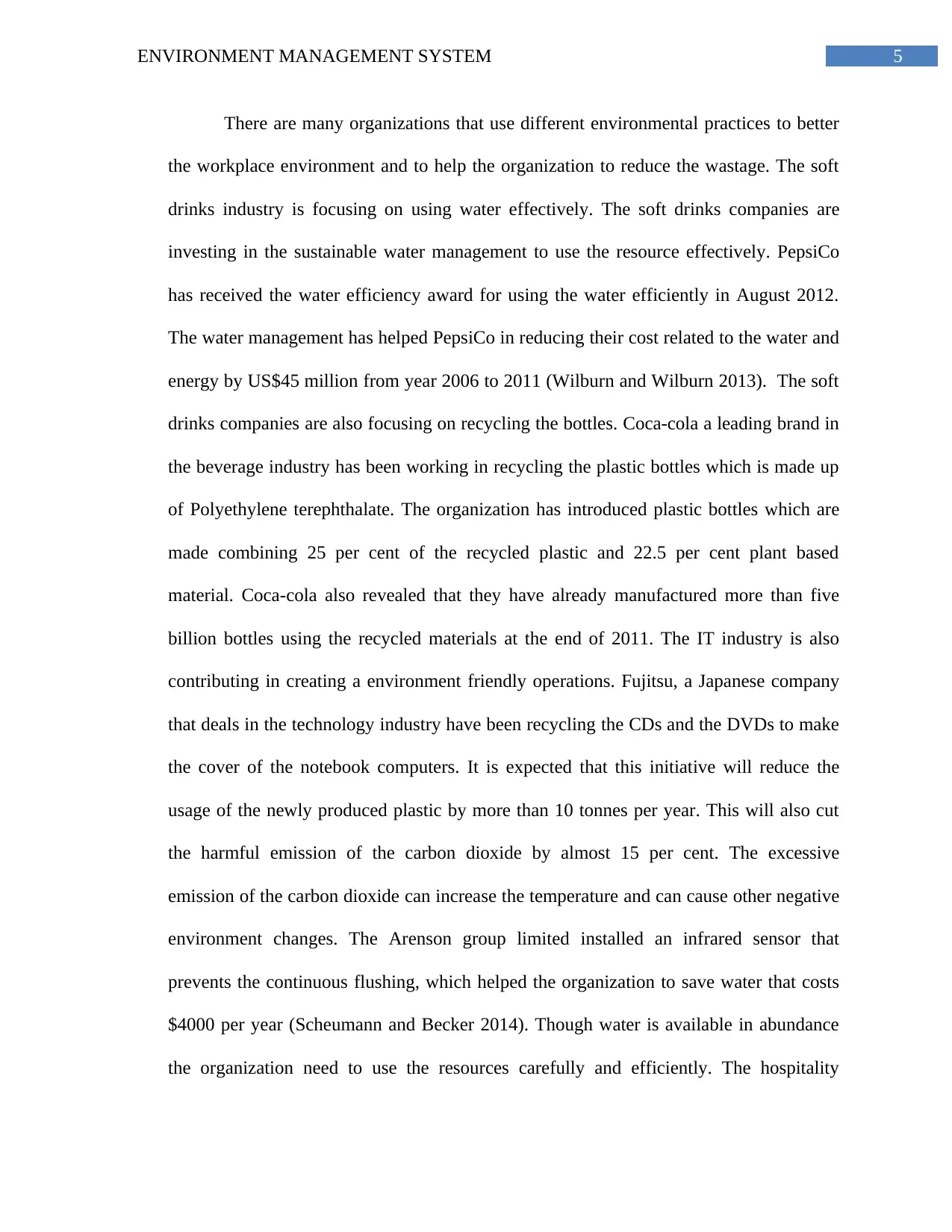
5ENVIRONMENT MANAGEMENT SYSTEM
There are many organizations that use different environmental practices to better
the workplace environment and to help the organization to reduce the wastage. The soft
drinks industry is focusing on using water effectively. The soft drinks companies are
investing in the sustainable water management to use the resource effectively. PepsiCo
has received the water efficiency award for using the water efficiently in August 2012.
The water management has helped PepsiCo in reducing their cost related to the water and
energy by US$45 million from year 2006 to 2011 (Wilburn and Wilburn 2013). The soft
drinks companies are also focusing on recycling the bottles. Coca-cola a leading brand in
the beverage industry has been working in recycling the plastic bottles which is made up
of Polyethylene terephthalate. The organization has introduced plastic bottles which are
made combining 25 per cent of the recycled plastic and 22.5 per cent plant based
material. Coca-cola also revealed that they have already manufactured more than five
billion bottles using the recycled materials at the end of 2011. The IT industry is also
contributing in creating a environment friendly operations. Fujitsu, a Japanese company
that deals in the technology industry have been recycling the CDs and the DVDs to make
the cover of the notebook computers. It is expected that this initiative will reduce the
usage of the newly produced plastic by more than 10 tonnes per year. This will also cut
the harmful emission of the carbon dioxide by almost 15 per cent. The excessive
emission of the carbon dioxide can increase the temperature and can cause other negative
environment changes. The Arenson group limited installed an infrared sensor that
prevents the continuous flushing, which helped the organization to save water that costs
$4000 per year (Scheumann and Becker 2014). Though water is available in abundance
the organization need to use the resources carefully and efficiently. The hospitality
There are many organizations that use different environmental practices to better
the workplace environment and to help the organization to reduce the wastage. The soft
drinks industry is focusing on using water effectively. The soft drinks companies are
investing in the sustainable water management to use the resource effectively. PepsiCo
has received the water efficiency award for using the water efficiently in August 2012.
The water management has helped PepsiCo in reducing their cost related to the water and
energy by US$45 million from year 2006 to 2011 (Wilburn and Wilburn 2013). The soft
drinks companies are also focusing on recycling the bottles. Coca-cola a leading brand in
the beverage industry has been working in recycling the plastic bottles which is made up
of Polyethylene terephthalate. The organization has introduced plastic bottles which are
made combining 25 per cent of the recycled plastic and 22.5 per cent plant based
material. Coca-cola also revealed that they have already manufactured more than five
billion bottles using the recycled materials at the end of 2011. The IT industry is also
contributing in creating a environment friendly operations. Fujitsu, a Japanese company
that deals in the technology industry have been recycling the CDs and the DVDs to make
the cover of the notebook computers. It is expected that this initiative will reduce the
usage of the newly produced plastic by more than 10 tonnes per year. This will also cut
the harmful emission of the carbon dioxide by almost 15 per cent. The excessive
emission of the carbon dioxide can increase the temperature and can cause other negative
environment changes. The Arenson group limited installed an infrared sensor that
prevents the continuous flushing, which helped the organization to save water that costs
$4000 per year (Scheumann and Becker 2014). Though water is available in abundance
the organization need to use the resources carefully and efficiently. The hospitality
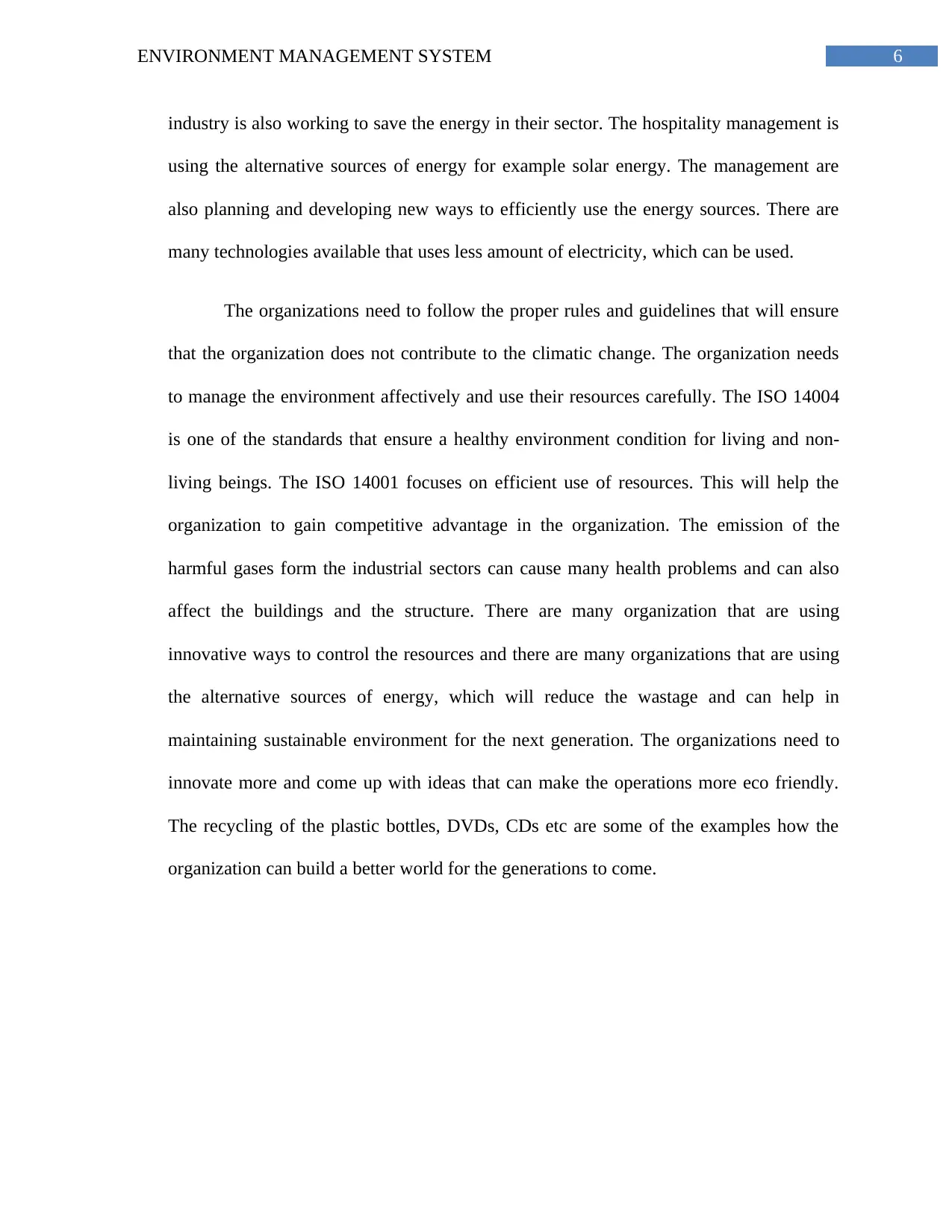
6ENVIRONMENT MANAGEMENT SYSTEM
industry is also working to save the energy in their sector. The hospitality management is
using the alternative sources of energy for example solar energy. The management are
also planning and developing new ways to efficiently use the energy sources. There are
many technologies available that uses less amount of electricity, which can be used.
The organizations need to follow the proper rules and guidelines that will ensure
that the organization does not contribute to the climatic change. The organization needs
to manage the environment affectively and use their resources carefully. The ISO 14004
is one of the standards that ensure a healthy environment condition for living and non-
living beings. The ISO 14001 focuses on efficient use of resources. This will help the
organization to gain competitive advantage in the organization. The emission of the
harmful gases form the industrial sectors can cause many health problems and can also
affect the buildings and the structure. There are many organization that are using
innovative ways to control the resources and there are many organizations that are using
the alternative sources of energy, which will reduce the wastage and can help in
maintaining sustainable environment for the next generation. The organizations need to
innovate more and come up with ideas that can make the operations more eco friendly.
The recycling of the plastic bottles, DVDs, CDs etc are some of the examples how the
organization can build a better world for the generations to come.
industry is also working to save the energy in their sector. The hospitality management is
using the alternative sources of energy for example solar energy. The management are
also planning and developing new ways to efficiently use the energy sources. There are
many technologies available that uses less amount of electricity, which can be used.
The organizations need to follow the proper rules and guidelines that will ensure
that the organization does not contribute to the climatic change. The organization needs
to manage the environment affectively and use their resources carefully. The ISO 14004
is one of the standards that ensure a healthy environment condition for living and non-
living beings. The ISO 14001 focuses on efficient use of resources. This will help the
organization to gain competitive advantage in the organization. The emission of the
harmful gases form the industrial sectors can cause many health problems and can also
affect the buildings and the structure. There are many organization that are using
innovative ways to control the resources and there are many organizations that are using
the alternative sources of energy, which will reduce the wastage and can help in
maintaining sustainable environment for the next generation. The organizations need to
innovate more and come up with ideas that can make the operations more eco friendly.
The recycling of the plastic bottles, DVDs, CDs etc are some of the examples how the
organization can build a better world for the generations to come.
⊘ This is a preview!⊘
Do you want full access?
Subscribe today to unlock all pages.

Trusted by 1+ million students worldwide
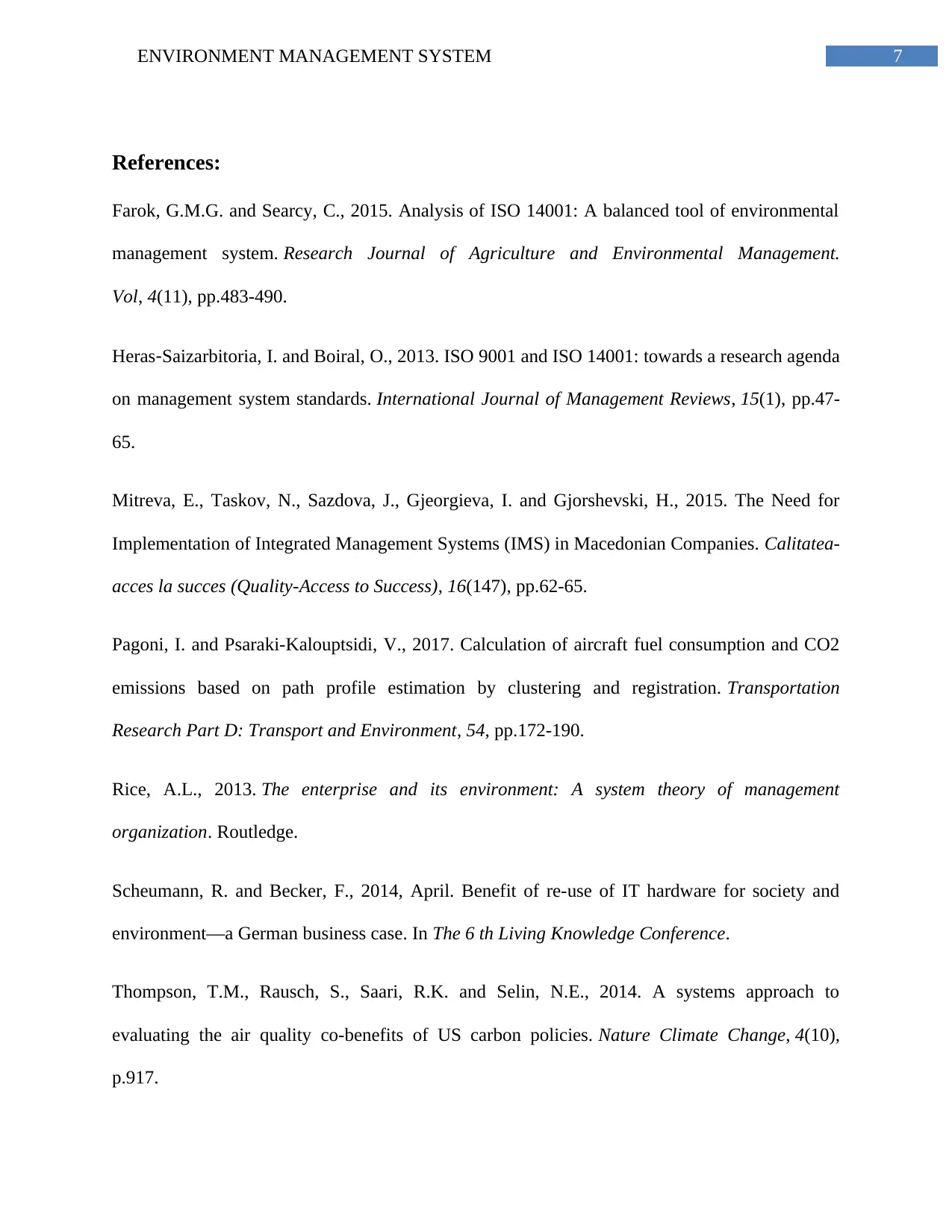
7ENVIRONMENT MANAGEMENT SYSTEM
References:
Farok, G.M.G. and Searcy, C., 2015. Analysis of ISO 14001: A balanced tool of environmental
management system. Research Journal of Agriculture and Environmental Management.
Vol, 4(11), pp.483-490.
Heras‐Saizarbitoria, I. and Boiral, O., 2013. ISO 9001 and ISO 14001: towards a research agenda
on management system standards. International Journal of Management Reviews, 15(1), pp.47-
65.
Mitreva, E., Taskov, N., Sazdova, J., Gjeorgieva, I. and Gjorshevski, H., 2015. The Need for
Implementation of Integrated Management Systems (IMS) in Macedonian Companies. Calitatea-
acces la succes (Quality-Access to Success), 16(147), pp.62-65.
Pagoni, I. and Psaraki-Kalouptsidi, V., 2017. Calculation of aircraft fuel consumption and CO2
emissions based on path profile estimation by clustering and registration. Transportation
Research Part D: Transport and Environment, 54, pp.172-190.
Rice, A.L., 2013. The enterprise and its environment: A system theory of management
organization. Routledge.
Scheumann, R. and Becker, F., 2014, April. Benefit of re-use of IT hardware for society and
environment—a German business case. In The 6 th Living Knowledge Conference.
Thompson, T.M., Rausch, S., Saari, R.K. and Selin, N.E., 2014. A systems approach to
evaluating the air quality co-benefits of US carbon policies. Nature Climate Change, 4(10),
p.917.
References:
Farok, G.M.G. and Searcy, C., 2015. Analysis of ISO 14001: A balanced tool of environmental
management system. Research Journal of Agriculture and Environmental Management.
Vol, 4(11), pp.483-490.
Heras‐Saizarbitoria, I. and Boiral, O., 2013. ISO 9001 and ISO 14001: towards a research agenda
on management system standards. International Journal of Management Reviews, 15(1), pp.47-
65.
Mitreva, E., Taskov, N., Sazdova, J., Gjeorgieva, I. and Gjorshevski, H., 2015. The Need for
Implementation of Integrated Management Systems (IMS) in Macedonian Companies. Calitatea-
acces la succes (Quality-Access to Success), 16(147), pp.62-65.
Pagoni, I. and Psaraki-Kalouptsidi, V., 2017. Calculation of aircraft fuel consumption and CO2
emissions based on path profile estimation by clustering and registration. Transportation
Research Part D: Transport and Environment, 54, pp.172-190.
Rice, A.L., 2013. The enterprise and its environment: A system theory of management
organization. Routledge.
Scheumann, R. and Becker, F., 2014, April. Benefit of re-use of IT hardware for society and
environment—a German business case. In The 6 th Living Knowledge Conference.
Thompson, T.M., Rausch, S., Saari, R.K. and Selin, N.E., 2014. A systems approach to
evaluating the air quality co-benefits of US carbon policies. Nature Climate Change, 4(10),
p.917.
Paraphrase This Document
Need a fresh take? Get an instant paraphrase of this document with our AI Paraphraser

8ENVIRONMENT MANAGEMENT SYSTEM
Wilburn, K. and Wilburn, R., 2013. Using global reporting initiative indicators for CSR
programs. Journal of Global responsibility, 4(1), pp.62-75.
Wilburn, K. and Wilburn, R., 2013. Using global reporting initiative indicators for CSR
programs. Journal of Global responsibility, 4(1), pp.62-75.
1 out of 8
Related Documents
Your All-in-One AI-Powered Toolkit for Academic Success.
+13062052269
info@desklib.com
Available 24*7 on WhatsApp / Email
![[object Object]](/_next/static/media/star-bottom.7253800d.svg)
Unlock your academic potential
Copyright © 2020–2025 A2Z Services. All Rights Reserved. Developed and managed by ZUCOL.




